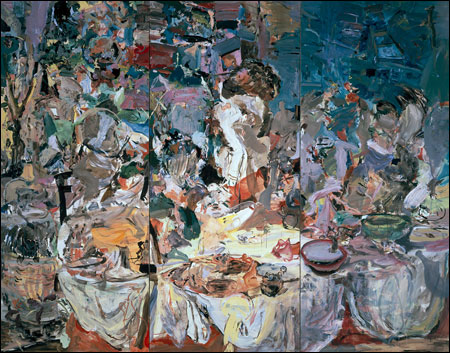Art-world sophisticates are schooled not to hunt for hidden pictures in abstract paintings, but that’s just what Cecily Brown encourages. It’s one of her tactics for holding our attention. So I dutifully search for the “darkened interior in which a figure reclines before a mirror in a provocative pose” that the wall text insists is buried in the surrealist jumble of Candy (1999). Is that a naked lady, with her legs spread wide, at the upper left? Or am I just seeing things?

THE PICNIC: A mad meltdown of John Tenniel’s illustration of the Mad Hatter’s tea party. |
Brown’s 10-year retrospective at the Museum of Fine Arts (organized by the Des Moines Art Center) flits giddily back and forth between representation and abstraction. In case you missed the notices in Vogue, W, and Vanity Fair, the 37-year-old London-born, New York–based superstar is making big Abstract Expressionist painting hip again.
Black Painting I (2002) is a blurry hungover memory of Goya’s etching The Sleep of Reason Produces Monsters. Her 2006 triptych The Picnic is a mad meltdown of John Tenniel’s classic illustration of the Mad Hatter’s tea party, or maybe the tumult of a Tintoretto Last Supper.
Creativity runs in Brown’s blood. Her mother is the Booker Prize–nominated novelist Shena Mackay. The late British art critic David Sylvester, a family friend, took her to art shows when she was growing up, once sneaking her into London’s Royal Academy after hours with his painter pal Francis Bacon. When she was 21, her parents revealed that Sylvester was her biological daddy. So it’s fitting that her work is packed with art-historical allusions.
Gangbusters (2001) is supposed to be based on one of those old master paintings of marauding soldiers politely kidnapping and gang-raping plus “a frieze of bunny-like shapes.” A pale person on all fours emerges from a cascade of yellow, tan, and orange brushstrokes in Tender Is the Night (1999). You can’t miss the couple lying next to each other and masturbating in the white-on-white dream These Foolish Things (2002).
Many observers hyperventilate over Brown’s randy imagery. She’s fascinated by people in heightened states — sex, death, rape, brawls — but this ain’t really her subject. “I don’t have a message,” she said at the MFA press preview, and I believe her. She’s into tapping wild energy, no matter its source, to fuel her racing brushstrokes. It’s how she musters the action for her action paintings.
The form comes out of de Kooning and Bacon. Her technique is plain in Lady Luck (1999), which seems to depict a flayed corpse with its head thrown back, eyes hollow meaty sockets, lush pink lips twisted into a smile. Or maybe it’s a lady in heart-shaped glasses having one of those petite morts. Brown isn’t a colorist; instead she fusses over the tonal range from light to dark. And she loves pushing paint around all spontaneous-like — from long lyrical brushstrokes and scrubbed-on color to short jagged jabs, where the paint collects energy and accelerates.